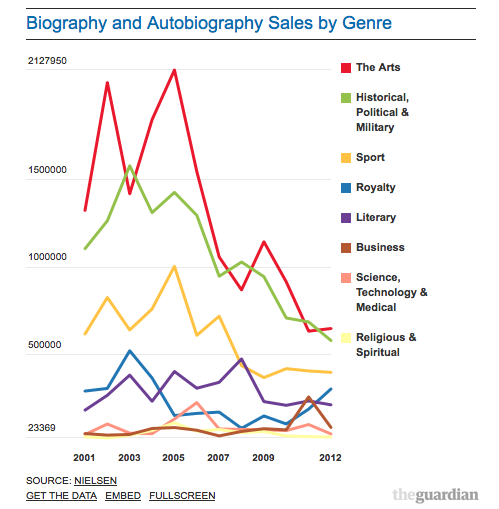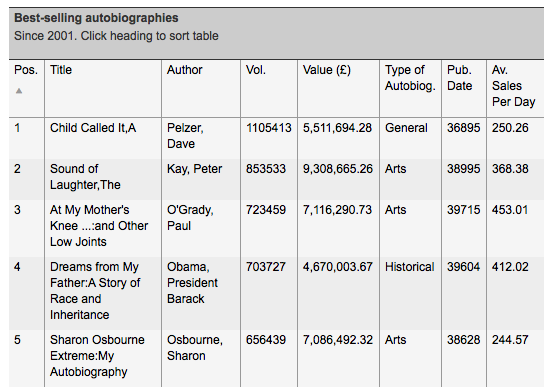As I was flipping through my ASTU notebook, I stumbled upon a couple of questions that I jotted down about a month ago during our discussion about autobiographical narratives. At the time, we were talking about how some life stories receive attention from the global community, while others remain silent. The question that I would now like to return to is this: “What kinds of life narratives become best-sellers and how can they affect others?”
While I was researching online, I came across a set of data posted by The Guardian that plotted the best-selling (auto)biographies since 2001. Although autobiographical work only made up a small percentage of book sales in 2012, it interesting how life narratives were at their peak of sales in 2001 and 2005. This set of data indicates several things. First, the genre, Arts, consistently remains at the top of all autobiographical book sales. Second, autobiographical book sales were at its highest during the years of 2001 and 2005. Lastly, after 2005, there has been a dramatic drop in the sales of autobiography. See below:
 How can we can make further sense of this data? In the article, Conjunctions: Life Narratives in the Field of Human Rights, Schaffer and Smith note how Post-WWII global transformations have led to an increased interest in the production of autobiography and concern over human rights. The first half of the new millennium were full of global conflicts and transformations; the early 2000’s also saw various wars begin and end, coup d’états, and other crises that should have resulted in a greater proliferation of life narratives about such global events. If there is a greater production and interest in autobiographical work (especially in the genre of Arts) during times of conflict, then it should explain why book sales in the early 2000’s were significantly higher, right?
How can we can make further sense of this data? In the article, Conjunctions: Life Narratives in the Field of Human Rights, Schaffer and Smith note how Post-WWII global transformations have led to an increased interest in the production of autobiography and concern over human rights. The first half of the new millennium were full of global conflicts and transformations; the early 2000’s also saw various wars begin and end, coup d’états, and other crises that should have resulted in a greater proliferation of life narratives about such global events. If there is a greater production and interest in autobiographical work (especially in the genre of Arts) during times of conflict, then it should explain why book sales in the early 2000’s were significantly higher, right?
Apparently not. I was quite surprised when I came across this next set of data detailing the 50 best-selling autobiographies since 2001. Here are the top 5:
Looking through this list, I notice that only one of the top 5 best-sellers is explicitly about trauma, specifically, child abuse. Somehow, our studies in ASTU class led me to believe that books explicitly about trauma and bearing witness, such as Persepolis and What is the What, would widely popular, and possibly best-sellers. However, as I scroll through the list of the top 50 best-selling autobiographies, I realize that a majority of these books are written by and catered to a predominantly “Western” audience. Judging from the book sales, minority narratives, particularly from the East, do not not have as great of a sale reception compared to narratives written by the West. Therefore, life narratives from the periphery may not be as widely distributed and consumed as we may think. This raises the issue of how consumers of life narratives may be neglecting the voices that are demanding to be heard and silencing accounts that speak about personal experiences such as trauma, oppression, and human rights abuse.
So now I end with even more questions: Are our priorities being shifted by those who control the book markets? How can consumers realize that their purchasing decisions they may be neglecting the voices that desperately need to be heard? Why has there been a decrease in the sales of autobiographies in the last few years, considering the tumultuous events that have occurred? What can we do about all this? Let me know what you think!


I really enjoyed your analysis of some hard data, Angela. I think it’s really interesting that minority autobiographies aren’t the bestsellers we may think them to be. (I was exactly the same as you– I thought that Persepolis and What is the What were tremendous successes. But looking at the whole picture, that doesn’t appear to be the case.
I believe that yes, our priorities are indeed being shifted by those who control the book markets. Allow me to make a connection to Google and facebook tailoring our ads. Just as this creates online filter bubbles, the specific Westernization of many autobiographies creates media bubbles.
And right now, we look to be trapped inside a big Western bubble. Just like it takes a tech-savvy individual to break free of online bubbles, it will take a market-savvy individual to break free of the media bubbles created by publishing houses. Luckily for us, a global citizen will be able to do so.
Angela, thank you for sharing this insightful post with us. Like Mary, I was also taken aback by the figures of your research into the best-selling life narratives, for I had also mistakenly assumed that life narratives dealing with trauma would be at the forefront of the best-sellers list. I think this links back to the Schaffer and Smith’s idea of the unpredictability of the marketplace: that is, it is almost impossible to pre-determine the autobiographies that will be taken up in today’s complex circuitries of consumption, and the ways in which the stories will be received and interpreted. (Schaffer and Smith 18). Some can become commodities and potent tools or “lightning rods” (Schaffer and Smith 16) for activism and reform, at the time as others recede into the background. While we can attempt to make some predictions about the narratives that will rise in popularity, I think that there is almost an invisible hand in the marketplace that regulates the life narratives that ultimately gain mass appeal.
Although steps could certainly be taken by activist groups to encourage people to acknowledge the implications of their preferences on specific genres and genre types on minority groups, I believe that this would imply making brash and unjustified judgments about which life narratives are worthy of being heard. It would mean that these groups would have to select the life narratives that they deem to be more deserving of a voice, thus denying other individuals the right to speak. All of this, nevertheless, is done by publishing companies when they pick out specific life narratives from a broad selection and send them out to the literary marketplace. In any case, do you think it will ever be realistic for everyone to put forward their experiences in life narratives?
With regards your question about the declining sales of life narratives, I think that the popularity of social networking sites like Facebook and Instagram has played a major role in engendering this fall. Given that now we now spend a substantial amount of our daily lives interacting with each other in social networking sites, our so-called voyeuristic desires (*Miller and Shepherd in “Blogging as Social Action: A Genre Analysis of the Weblog”) are perhaps now partly fulfilled by these sites, so there is less of a need to reach out to written autobiographies. What do you think?
Yeah, I agree with you, – a lot of life narratives can be accessed online, and not in the form of books like you mention. To answer your question, I think most people (that is, users of social networking sites) willingly put out the experiences of their everyday lives and produce their own life narratives. Obviously, this applies to people who have access to such technology, because there are places in the world where access and ability to sharing life stories is limited.